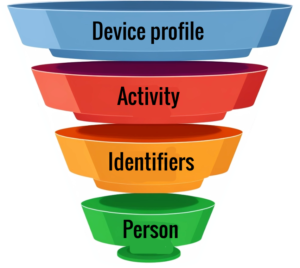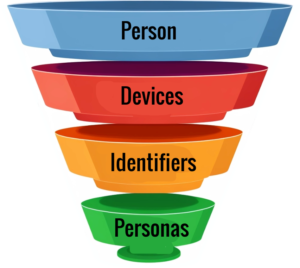Today’s post is the first of a multi-part series based on a presentation I did at the Martech conference. I’ll post links to the other parts and to the full presentation below.
When you’re building out a customer data platform you need to focus on your use cases, and in order to build successful use cases you should examine them from two different perspectives: first, from the data you collect from devices, and second, from the perspective of your customers as human beings.
I call these two the device framework and the person framework.
To understand this, let’s back up to some fundamentals. The internet is based on a request and response system. For example, my Android phone sends a request to Krehbielgroup.com, and the web server sends a response. The point is that people don’t visit websites. Devices do.
 So let’s walk through the device framework.
So let’s walk through the device framework.
- A device makes a request.
- That device has activity.
- You collect identifiers on that device.
- You try to resolve devices to a person using those identifiers.
There are different use cases for each step of that framework.
For #1, you might target iPads differently than iPhones.
For #2, you can target every device that views content with a particular tag, like “retirement.”
For #3, try to collect identifiers – like IP address, location, usage patterns, or better yet, an email address – that will help resolve to a person.
For #4, try to match all the devices a person uses to a single person.
The device framework is somewhat like the measuring left-brain side of things and the person framework is somewhat like the creative right-brain side of things.
 A person is a much more complicated thing than a device, because one person can have many devices and many personas. The person framework goes like this.
A person is a much more complicated thing than a device, because one person can have many devices and many personas. The person framework goes like this.
- A person
- Has many devices
- Has many identifiers that
- Resolve to different personas
People try to hide their identity by using different browsers, different devices, incognito mode, etc. Many people also don’t buy into the tech nonsense of “bringing your whole person.” Facebook wants one profile per person, but people compartmentalize their lives. They have a work life and a home life. A professional life and a hobby. They might want to keep their political or social views separate from their professional image.
I’ll go into this in more depth in a later podcast, but for now, just remember that you need to think about devices and people on two separate tracks. Once you’ve been through both of those, re-evaluate your use case to make sure it addresses all the little wrinkles and exceptions and weirdness you discovered by using these two frameworks.
Links
Part 2: Fine-tune CDP personalization with these two use case frameworks
Part 3: Deterministic v probabilistic matching in a customer data platform
The full presentation: Two frameworks to harmonize identity and business needs




